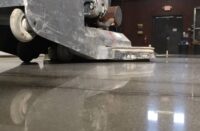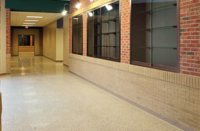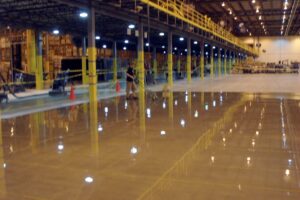 What is the best concrete polishing process for your job? Should you polish concrete wet or dry?
What is the best concrete polishing process for your job? Should you polish concrete wet or dry?
To determine the answer, you must ask the following questions before each job. What is the condition of the concrete floor, the environment it occupies, and the desired look of the finished product?
The answers and other expectations will play a role in your decision. Many times, it may be best to use a combination of wet and dry polishing.
Wet polishing is the oldest form of polishing. It is probably the concrete polishing process you’re most familiar with. Natural stone is most often polished wet and has been for centuries. In the earliest days of polishing, concrete floors were polished wet.
However, over the years, people discovered dry polishing increased the level of shine. So companies began to create equipment and tooling for dry grinding and polishing.
Over the past decade, dry grinding has been the most popular method in the United States. However, wet polishing has made a significant resurgence as part of the “go green” craze. And with the bid process, it has become more and more competitive.
Which is greener
People disagree over which method is greener. Dry grinding solves the disposal problem much more efficiently, as it doesn’t produce slurry. The regulations on slurry disposal vary from one jurisdiction to another. Therefore, you should research regulations before disposing any slurry. Contractors need to have the proper wet-vac system, which can be purchased or rented.
Wet grinding solves another environmental problem, silicosis. Wet grinding and polishing eliminate the dust clouds that can come from dry polishing. Asbestos became a huge problem for the flooring industry. Likewise, silicosis has the potential to become a similar problem for the concrete polishing industry. Even with a large dust extractor in use, workers can inhale a great deal of dust when dry-polishing concrete.
Employers should always make masks available on job sites. When dry grinding, workers should wear them. Also, they should take special care in retail environments, as well as environments where customers or facility employees remain while crews grind. Crews also must clean up dust in retail environments at the end of each day and not leave it on merchandise.
Wet has its advantages
Wet grinding and polishing also increase diamond life dramatically on medium-hard to very hard floors and allow for more aggressive grinding. Grinding wet can effectively remove a significant layer of concrete to expose aggregate. It allows the diamonds to cut faster on medium-hard and very hard floors.
Any contractor who has exposed aggregate knows it can take a long time to grind an entire slab down to larger aggregate. It takes time to take out high spots and expose aggregate as evenly as possible. Wet grinding creates more friction. And, more importantly, it keeps the diamond tooling cooler, which prevents metal-bond tooling from glazing over.
Using water in the first two or three steps of polishing helps remove scratches left behind by the metal-bond diamonds. Crews can finish out the floor using wet polishing in the higher grits for a duller, easier-to-maintain shine level.
Dry delivers more shine
However, dry polishing will always give the floor a much higher level of shine than wet polishing. It will provide a much higher level of light reflection and a classier-looking floor.
Dry polishing will also always work better on a soft concrete floor. Soft concrete can wear even the hardest diamond bonds out far faster than expected. This causes job costs to surge and profits to dwindle. While polishing wet on these floors, the diamonds could grind over-aggressively and leave gouge marks in the floor.
Crews don’t necessarily have to do a whole job using one method or the other. They can grind wet and polish one step wet. Then they can polish dry to get a high shine and still keep costs and dust under control. The last few steps of polishing leave behind very little dust.
Experience counts
Quality concrete grinding and polishing require an experienced contractor. They require a contractor who knows what’s best for his customer, one not overly dependent upon the advice of vendors. Experienced contractors will consider the client’s best interests and profitability as well as their own.
Concrete polishing is a young and evolving industry. It is too early to make absolute and permanent determinations of any kind. Contractors need to take control of their own destiny and constantly reeducate themselves. They need to always think of their own profitability and exposure and weigh the best approach on each given job.
Contractors also need to play a role in the education of general contractors and end-users. They need to not leave this task entirely up to the vendors supplying the concrete contractors. The contractor needs to make certain his best interests aren’t left out of the equation.
Smaller, newer contractors in the concrete polishing industry must take extra-special care to continually learn how to provide polished concrete floors faster, cheaper and better. Larger and more established contractors control a larger and larger percentage of the work done — especially big jobs. Established contractors have more negotiating power with vendors. They have the leverage to be recommended by the vendor for large jobs. This is especially true with jobs done by chains and on a national level.
Without intending to do so, vendors can become virtually aligned with certain contractors. The system snowballs as the vendor aids the largest contractors. Then the largest contractors become larger and larger and obtain an ever-growing influence over the vendors. This can’t be avoided in any industry.
Margins dwindle, especially for the smaller contractor. Thus, the smaller contractor needs to be especially open-minded about cost-controlling methods. This will allow him to remain competitive.















